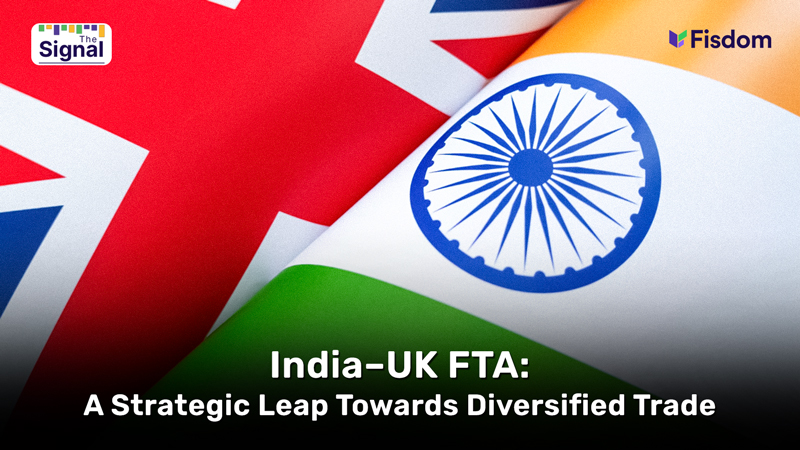
On 6th May 2025, India and the United Kingdom concluded negotiations on a landmark Free Trade Agreement (FTA), marking a significant turning point in bilateral economic relations. With historical ties and strong trade linkages, the agreement aims to deepen commercial integration, promote job creation, and reduce overdependence on traditional partners like the United States and the European Union.
What is an FTA?
A Free Trade Agreement is a treaty between two or more countries to reduce or eliminate tariffs, quotas, and preferences on goods and services traded between them. FTAs are designed to boost cross-border investment, streamline regulations, enhance market access, and facilitate the mobility of professionals.
The India–UK FTA sets an ambitious target: eliminate 85% of tariffs and reduce 90% within the next decade. The deal is expected to boost bilateral trade in goods and services to USD 60 billion annually, with potential to double by 2033.
Key Highlights of Tariff Reductions
The FTA covers a broad spectrum of sectors, benefiting both economies by reducing import and export duties on critical goods.
Imports to India from the UK (Tariff Reductions)
| Category | Products Included |
| Beverages & Cosmetics | Whiskey, gin, soft drinks, cosmetics |
| Automobiles & Machinery | Luxury cars, aerospace parts, electrical machinery |
| Food & Medical Supplies | Lamb, salmon, chocolates, medical devices |
Exports from India to the UK (Tariff Reductions)
| Category | Products Included |
| Apparel & Footwear | Clothing and footwear |
| Food Products | Frozen prawns and other seafood |
| Gems & Jewellery | Precious metals and stones |
| Automotives & Pharma | Cars, motorcycles, generic medicines, pharmaceuticals |
Strategic Advantages for the UK
The UK stands to gain substantially in terms of:
- Expanded Consumer Access: Indian textiles, pharmaceuticals, and food products will offer UK consumers greater variety at lower prices.
- Market Diversification: In a post-Brexit environment, reducing overreliance on the US and EU is a strategic imperative.
- Business Expansion: UK companies, especially in beverages, aerospace, and luxury automobiles, gain easier access to one of the fastest-growing consumer markets.
UK Beneficiaries
| Sector | UK Company / Brand | Indian Market Impact |
| Alcohol | Diageo (Johnnie Walker, Tanqueray) | Higher volumes via lower tariffs |
| Automotives | Jaguar Land Rover (Tata Subsidiary) | Improved margins and sales |
| Aerospace | Rolls-Royce, BAE Systems | Joint ventures and increased exports |
What’s in it for India?
India secures preferential access to a high-income export market, which has remained relatively underexploited till now.
Key Sectoral Benefits
- Automobile Sector: Indian companies like Tata Motors (JLR), Eicher Motors (Royal Enfield), and TVS (Norton Motorcycles) stand to gain from relaxed tariffs and stronger branding in the UK.
- Jewellery & Gems: Titan and Kalyan Jewellers can expand their footprint in the UK with lower costs for customers.
- Textiles: One of India’s largest labor-intensive sectors will benefit from expanded access to premium markets.
- Pharmaceuticals: The UK becomes a viable alternative to the US market, especially after regulatory challenges like USFDA scrutiny and executive actions under the Trump administration.
India Beneficiaries
| Sector | Indian Company | Export Potential Increase |
| Automobiles | Tata Motors, TVS, Eicher | Increased brand visibility and market share |
| Jewellery & Gems | Titan, Kalyan Jewellers | Duty-free access boosts competitiveness |
| Pharma | Cipla, Sun Pharma, Lupin | Easier entry, faster regulatory clearance |
| Textiles & Apparel | Multiple SMEs & exporters | Wider UK retail access, low-cost sourcing |
Moving Beyond the US
A crucial geopolitical driver for this agreement is the recent imposition of Reciprocal Tariffs by the US, disrupting traditional trade flows. The Trump-era executive orders introduced unpredictable barriers, especially for Indian pharmaceutical companies and IT service providers. The India–UK FTA is a strategic hedge, diversifying trade relationships and reducing vulnerability to sudden policy changes by any single country.
To Summarise
The India–UK FTA is not just about tariff reductions—it’s a strategic, economic, and geopolitical alignment between two democratic, service-driven economies. While the agreement’s full impact will take a year or more to materialize, early signs are promising. Analysts forecast a sharp rise in bilateral trade volume, enhanced investor sentiment, and the creation of thousands of jobs across both nations.
As global trade becomes more regionalized and interest-driven, this FTA positions India and the UK as agile, forward-looking partners with a shared vision of prosperity. For businesses and consumers alike, this is an opportunity to engage in deeper, mutually beneficial trade in an increasingly uncertain global economy.
Market this week
| 05th May 2025 (Open) | 08th May 2025 (Close) | %Change | |
| Nifty 50 | ₹ 24,420 | ₹ 24,008 | -1.7% |
| Sensex | ₹ 80,662 | ₹ 79,454 | -1.5% |
Source: BSE and NSE
- Indian equity benchmarks ended their three-week winning streak, falling over 1% for the week ended May 9, primarily due to ongoing border tensions with Pakistan.
- This decline came despite favorable global developments such as the progress in US-UK trade discussions, continued US-China trade talks, an ECB rate cut, foreign fund inflows, and the UK-India Free Trade Agreement (FTA).
- Sector-wise, the Nifty Realty index saw the steepest drop, declining by 6.5%, followed by a 4.4% loss in the Nifty PSU Bank index.
- Key indices including Nifty Bank, Pharma, Energy, and Oil & Gas also posted losses exceeding 2%.
- In contrast, Nifty Auto and Media outperformed, each gaining over 1% during the week.
- Foreign Institutional Investors (FIIs) extended their buying streak to a fourth consecutive week, with net equity purchases totaling Rs 5,087.42 crore.
- Domestic Institutional Investors (DIIs) also maintained a bullish stance, investing Rs 10,450.96 crore in equities over the week
Weekly Leaderboard
| NSE Top Gainers | NSE Top Losers | ||||
| Stock | Change (%) | Stock | Change (%) | ||
| Tata Motors | ▲ | 8.7% | Sun Pharma | ▼ | -4.6% |
| Titan Company | ▲ | 5.1% | Asian Paints | ▼ | -4.6% |
| L&T | ▲ | 3.4% | IndusInd Bank | ▼ | -4.1% |
| Adani Ports & SEZ | ▲ | 3.1% | Jio Financial | ▼ | -4.0% |
| Hero Motocorp | ▲ | 3.0% | NTPC | ▼ | -3.9% |
Source: BSE
Stocks that made the news this week:
Capital market-related stocks witnessed notable declines on May 9, as escalating geopolitical tensions between India and Pakistan weighed heavily on investor sentiment. The Nifty Capital Markets index fell over 2% during afternoon trade, settling around the 3,609 mark. The broader market mood turned cautious, with the India VIX—a measure of market volatility—spiking by nearly 8% in early trading hours, reflecting heightened nervousness among participants.
Shares of Multi Commodity Exchange (MCX) tumbled over 6% to Rs 5,635 following the release of its Q4 FY25 financial results, which came in below market expectations. Despite reporting a strong 54% year-on-year growth in net profit to Rs 135.46 crore, the performance failed to impress investors. In addition to the earnings, MCX declared a final dividend of Rs 30 per share for the financial year.
In contrast to the broader market weakness, select PSU banking stocks gained ground on the back of robust March quarter earnings. The Nifty PSU Bank index rebounded 3% from its intraday low, with Union Bank of India emerging as a standout performer. The stock surged 7% to Rs 123 after the bank posted a 50.58% jump in Q4 FY25 net profit to Rs 4,984.92 crore. Its net interest income also edged up slightly to Rs 9,514 crore, reinforcing investor confidence amid a largely risk-averse trading session.














